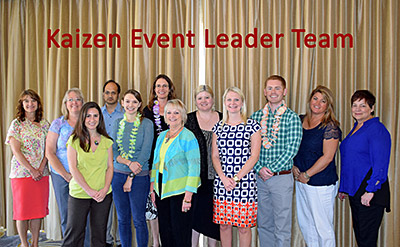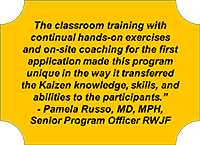Monday, August 18, 2014 - Would you like to have more speed, involvement, and results for your improvement projects?
Written by PHQIX Expert Panel member Chris Bujak and his business partner Pam Vecellio, of Continual Impact LLC. Visit the Ask an Expert page for more advice from PHQIX Expert Panelists.
Kaizen is a QI method that can help. The COPPHI Kaizen Event Program recently provided training for individuals from 10 health departments, through a competitive process, for intensive kaizen education, onsite coaching about application of the kaizen methodology, and participation in a learning community. The program was funded by the Robert Wood Johnson Foundation (RWJF), and managed by National Network of Public Health Institutes (NNPHI); training and coaching were provided by Continual Impact LLC.
Kaizen simply means “change for the better”. A kaizen event is a team-based approach to problem solving that flows through all phases of the improvement cycle effectively and rapidly. Before the event, a kaizen-appropriate problem is identified along with goals in areas such as customer satisfaction, cycle time and labor reduction, and error elimination. The team is then mobilized and a kaizen event begins. A typical event uses a systematic process to identify waste in the targeted work process, to enable the team to understand and analyze the root causes, to identify and test solutions, to learn, to install improvements, and to create a system for ongoing improvement. As the event progresses, numerous QI and change management methods and techniques are applied. All of this work is accomplished in a brief period of time, typically 5 days, with full benefits achieved within 1-3 months!

To prepare, the event leader team completed 48 hours of face-to-face foundational QI, kaizen, and facilitation education using an application-intensive, “Tell, Show, Do, Recycle” (receive feedback)  approach to solidify the learnings. During the preparation and post-event, each event leader received personalized coaching. Ten kaizen events were then conducted (one at each site) where each event leader co-led the event with an onsite Continual Impact LLC coach helping and providing feedback. Each event team completed all phases of the improvement cycle and then immediately followed up by rolling out the new process and installing an ongoing improvement system for monitoring progress and creating even more improvements!
approach to solidify the learnings. During the preparation and post-event, each event leader received personalized coaching. Ten kaizen events were then conducted (one at each site) where each event leader co-led the event with an onsite Continual Impact LLC coach helping and providing feedback. Each event team completed all phases of the improvement cycle and then immediately followed up by rolling out the new process and installing an ongoing improvement system for monitoring progress and creating even more improvements!
Kaizen events can also be a powerful way to support Public Health Accreditation Board accreditation, engage people, and help develop a culture of improvement in your agency. Kaizen leverages the power of the people who perform the work; engages leadership in a meaningful and supportive fashion; focuses the improvement so it aligns with the organization’s needs and can be done rapidly; uses learning from the work site to identify practical solutions; applies numerous, detailed improvement methods during the event to empower the individual and effectively solve problems; and implements the solutions quickly and sets the stage for further improvements.
and help develop a culture of improvement in your agency. Kaizen leverages the power of the people who perform the work; engages leadership in a meaningful and supportive fashion; focuses the improvement so it aligns with the organization’s needs and can be done rapidly; uses learning from the work site to identify practical solutions; applies numerous, detailed improvement methods during the event to empower the individual and effectively solve problems; and implements the solutions quickly and sets the stage for further improvements.
See the program summary of the event results here. Over the next few weeks more information on the 10 Kaizen projects will be highlighted in future articles.
Comments
Elongated Post Event
Thanks so much for this article on the COPPHI KAIZEN EVENT PROGRAM! I'd like to ask a question. We did a Kaizen for our Food Safety program focusing on improving service to non-English and ESL food operators. Because food establishments are inspected infrequently, our post event is much longer than the 3 weeks you outline in this article. Is this unusual? Our Kaizen team felt that the preparation for and the Kaizen event itself was very worthwhile but it's impossible for us to implement our improvements and collect data until we're at least 6 months out.
Food Safety Program Kaizen
It is good to learn about your application of kaizen to focus the team on improving Food Safety services. Not having a detailed understanding of how you approached the kaizen steps of confirm, prepare, perform, and institutionalize, we are not able to specifically answer your question. Implementing the improvements and measuring results 6 months out can pose several challenges, such as loss of team engagement, forgotten root causes or solutions.
Some tips to facilitate more immediate action and feedback - Confirm: Use the kaizen improvement goal and measures is confirm the event scope and that the team’s event benefit realization expectations meet the needs of your department. Prepare: Synchronize the work and the event timing and prepare team members and stakeholders for immediate installation (within 2 weeks of the kaizen). Time the event so that you can measure and realize benefits within 1-3 months. Perform: Test out the solutions within the kaizen so that you have data showing the solutions will be successful. This can really energize and rally team support of the changes. Institutionalize: Track on-going performance, results (outcome) measures and in-process measures (activity or resource).
While you may not have measurable results data for the Food State program kaizen yet, continue to improve the process by establishing a feedback mechanism for team members to share what it going well, what is not going well, suggestions to make the process event better.